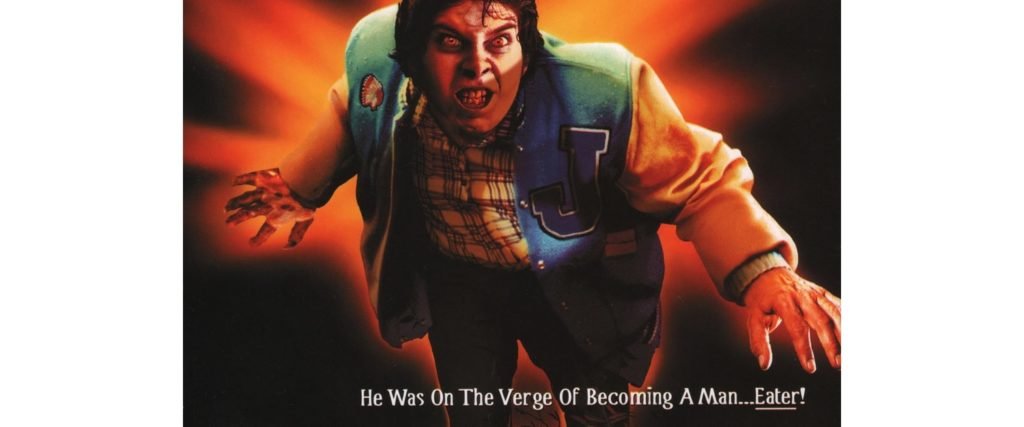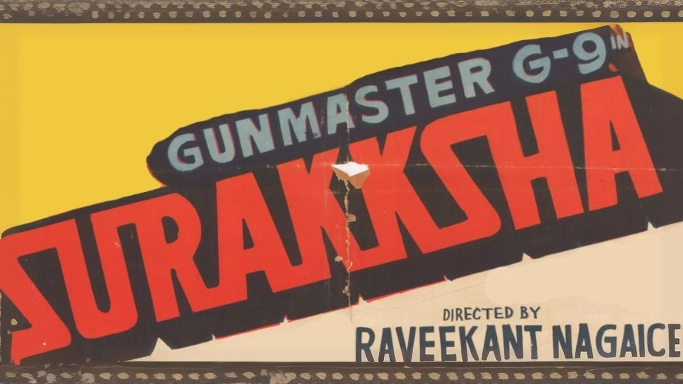Title: The Beast Within
Cast: Ronny Cox, Bibi Besch, Paul Clemens, Don Gordon, R.G. Armstrong
Director: Philippe Mora
Nutshell: A twisted metaphor on the nightmare of rape? Maybe not, but a fun twist on the usual werewolf routine with a showstopping transformation scene. Whacky and uneven but compelling.

On a dark stormy Mississippi night in 1964, the newlyweds are manfully trying to make their honeymoon destination but making little headway. The banged-up old car has seen better days and is now struggling to drive through the rain and winds. Soon enough, there is a mishap on the road, and the car is hurtling into some gooey, sticky mud where it gets rather stuck out in the middle of nowhere. Meanwhile, the audience is shown a shackled hairy beast who breaks free of his restraints and lumbers out of his confines into the open forest in highly ominous form.
Ronny Cox (as husband Eli McCreary) trudges off into the rain to get help leaving the wife, played by Bebe Besch, in the car alone. Their dog runs for it from the vehicle, and Bebe goes after him, only to be horrified when he is mangled and tossed aside like a piece of waste in front of her eyes. The Beast is about to set upon her, but she runs for it and makes modest progress when she slams into a branch and passes out. The Beast strips her clothes off and proceeds to rape her while she remains unconscious, and Mr McCreary arrives moments too late and finds his wife lying almost dead but has the sanity to get her to medical help fast enough to save her.
Seventeen years pass, and the same couple are still together, and they are again at the hospital, but this time, it is because their son Michaels’s health appears to have deteriorated to the point that he is barely being kept alive by artificial intervention. Michael lapses out of consciousness on his sick bed and occasionally dreams of approaching the same dark, broken-down house containing a mysterious basement as though his calling is summoning him.
The parents return to Mississippi to find what ails their son, knowing the boy was born from the tortuous rape Mrs McCreary suffered 17 years ago. They returned to find out if there was any history of illness or some congenital disorder with the biological father. However, they find that the sheriff and the town administration are not thrilled at their visit, asking questions and digging for answers. These people carry a secret about what happened the night of the rape all those years ago, how justice was done, and who was the benefactor. It’s all very murky and sordid business, and it all resurfaces with the arrival of the McCrearys who disturb the peace in otherwise tranquil Noiba, Mississippi.
Gradually Michael starts to get sicker and sicker, and his dreams are more vivid than before. He follows his killer instinct and finds that he has a bloodlust that he must satiate and does so in a brutal manner. One by one, various members of the odious community start to show up at the morgue in an increasingly gruesome state, disembowelled and with their necks gouged out. After each kill, Michael starts to recover and look better until he must kill again to satisfy his bloodlust.
The moment of truth arrives when he has to fight off a murderous instinct and somehow tear himself away from his girlfriend before killing her, but the urge is too forceful to handle, and his bloodlust needs to be satisfied. Finally, on the hospital bed, strapped up like Regan from The Exorcist, the young Michael McCreary undergoes a most dreadful and appalling transformation as his face balloons up to resemble a cross between Donald Trump and Kim Il Jung with a serious case of The Mumps. It’s the film’s showstopper climax and, for its time, was among the first films that attempted a physical transformation scene using prosthetics and make-up rather than stop-motion animation.
The Beast Within arrived at a time when horror make-up and effects had found the new “thing”, specifically “transformation” scenes that were done by prosthetics and make-up rather than the old fashioned animated stop motion animation techniques used for so long. The Howling had startled horror audiences with its wonderful, groundbreaking man-to-werewolf transformation scene and had set the bar for the particular effect. An American Werewolf in London arrived six months or so later. With its substantially larger budget and genius Rick Baker at the helm, a new high was again set for the physical transformation. These scenes were the film’s major draw in both movies: the trump card.
The Beast Within, therefore, had some excellent work to match. Though the effects are a little rough and ready compared to the two previous films, they are Over the Top enough to hold their own in the spectacular stakes despite their ridiculousness. And if that wasn’t quite enough, there is a stunning decapitation to top things off as in 1982, the horror genre was in the dizzy boom-time period, and increasingly the make-up and FX experts had to try somehow to retain some sparkle to an increasingly over-saturated horror scenario as emerged in around 1982. The horror boom fueled by Halloween and Friday the 13th rapidly ran out of ideas. As Hollywood struggled for fresh ideas and plots, the FX teams had to take centre stage, often being the only saving grace in an increasingly over-saturated genre. It wasn’t until A Nightmare on Elm Street arrived horror had something fresh and exciting to rave about.
The Beast Within was initially marketed as a sort of Werewolf film emphasising the full moon and the transformation from man to Beast. Still, though it may take more than a leaf out of the werewolf legend, The Beast Within is not a werewolf movie. Written by Tom Holland, who has serious horror credentials, the film ends up as a fairly satisfying and gruesome horror romp but suffers from a meandering middle portion that frequently borders on the tedious and dreary. The thrilling transformation arrives late and almost saves the day with its outrageous goofiness, if nothing else.
The Beast Within may not be the most memorable horror film of its era, but it should be given credit for at least stepping away from the standard slasher movie fare that was being churned out in 1982 instead of opting to go for a pseudo werewolf movie where a Cicada replaces the werewolf! The first 30 minutes of the film are well constructed, fairly atmospheric, and well edited, but the next 45 minutes have some good moments followed by some that are dull and uninspired, but then there is redemption with the insane climax and beyond.
Not perhaps a great movie, nor a very scary one, but one that was among the first three movies to have “transformation” scenes and at least was a change from the dreary slasher template everyone appeared to be using to death in the early 1980s.









